Historic Churches of the Augustana Evangelical Lutheran Church
Written and compiled by Bruce D. Johnston
Download a Printable Copy in Adobe Acrobat format

The Jenny Lind Chapel located adjacent to Augustana Lutheran Church, Andover, IL. Mother Church of Augustana Synod, Dedicated 1854. Funds provided mainly by Jenny Lind, the "Swedish nightingale"
Augustana Lutheran Church, Andover, Illinois | The Augustana Evangelical Lutheran Church came into the Lutheran Church in America in 1962 with 629,547 members in 1,269 congregations, of which 49 were in Canada. While all were precious in God's sight, some have stories which may have power to re-kindle faith and imagination in 21st century Christians.
Lutheran Church history books tell us that 1860 is the date when then "Augustana Synod" was organized. But there could be no Synod, LCA or ELCA, unless first there were congregations. And before that, there were Christians who decided to form worshipping communities according to the doctrine and liturgy of the Church of Sweden.
Augustana Lutheran Church, Andover, is such a community. By the time the Augustana Synod came along, the Andover congregation was ten years old. Ten was also the number of charter members, the list headed by the name of Lars Paul Esbjörn, Andover's pastor from 1850 to 1856. There was no mission board to tell Pastor Esbjörn not to organize the congregation until there were 100. Nor can we understand why so few from Esbjörn's flock from Sweden signed up, nor why so many became Methodists. Nonetheless, the Andover Church grew and welcomed the Augustana Synod in 1940. By then, Andover was seen as the "cradle of our Synod, where its first congregation was organized on March 18, 1850." But Pastor Esbjörn's field was larger: from New Sweden and Burlington, Iowa, to Galesburg, Princeton, and Rock Island, Illinois. And did you know that Esbjörn was the first president of Augustana College and Theological Seminary? The 1940 the Andover Yearbook warns us not to forget Esbjörn, "nor his wife, whose mortal remains lie buried a few feet away from the old church for which the boards for her coffin were intended."
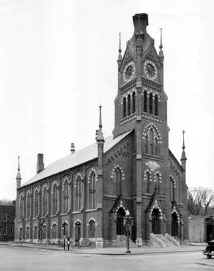
First Lutheran Church, 5th Avenue and 13th Street, Moline, Illinois. Cornerstone laid June 15, 1876; bell tower finished 1979; debt liquidated 1889.
First Lutheran Church, Moline, Illinois | When you read the histories of Augustana Synod and its congregations, names like Esbjörn, Hasselquist, Norelius, Carlsson, appear often. While the Augustana Synod and its educational institutions revere them as pastors and educators, they spent much of their time and energy on "home missions." Of the 19 ordained pastors present at the June 7, 1860, organization of Augustana Synod, most were born in Sweden, and a few in Norway. However, only six were ordained in "the old country." The rest (yes, even Norelius) were ordained by the Synod of Northern Illinois.
Church of Sweden Pastor Lars Paul Esbjörn was multi-tasking before we knew what that was. Consider how he brought his wife and six children, along with a number of other immigrants on a voyage to New York City, leaving Sweden June 29, 1849. It took them two months, eight days. They settled in Andover, where the first Augustana congregation was born. It wasn't long before Esbjörn followed some of the immigrants to Moline, and on December 1, 1850, in a rented room, organized First Lutheran Church, Moline, Illinois.
First Lutheran Church Pastor L. K. Anderson put it this way: "They wanted work. They wanted homes. They wanted education. They wanted to worship God. And so, on December 1, 1850, Dr. Lars Paul Esbjörn met with a small group and organized First Lutheran Church."
Call it a two-point parish, if you will, Esbjörn divided his time between Andover and Moline. But that was not enough for Esbjörn. The people needed the Word of God and the Sacraments, to be sure, but they also needed education.
When First Lutheran Church celebrated her centennial in 1960, the booklet featured letters of greeting from six Augustana luminaries. Most instructive is the letter from Augustana College President Conrad J. Bergendoff:
Augustana and First Lutheran of Moline have a common founder. For L. P. Esbjörn who laid the foundations of First Moline while he was pastor in Andover was also the guiding spirit in the beginnings of Augustana College and Theological Seminary. It was Esbjörn who organized both the Moline congregation in 1850 and the Chicago institution in 1860. He preached the Word and administered the sacraments in the one, in the other he taught theology, but also languages, mathematics, history and geography. In 1875 the College and Seminary moved to Rock Island, thus bringing into close proximity the institution and the congregation&emdash;the common origins&emdash;emphasize a kinship between Church and School, between faith and learning, which has been a precious heritage of the Augustana Church.
John Fryxell related to his son Fritiof Fryxell many of his early experiences in Moline when he arrived by train at nightfall on October 11, 1878. Spending his first night in a room above a saloon, John looked for a church on the following Sunday:
"the first Sunday I was in Moline I went to the Swedish Lutheran Church (now First Lutheran). It was just being built; the basement was finished, but the upstairs was still unplastered. However, the upstairs was opened for services that Sunday for the first time, all previous services having been held in the basement. We sat on planks set out for the occasion. Professor Olof Olsson preached as Rev. A. G. Setterdahl, the regular pastor, was absent for the day."

First Lutheran Church, Seminary and Water Streets, Galesburg, Illinois. The third structure built by the congregation, welcoming the faithful from 1928 through the present day.
First Lutheran Church, Galesburg, Illinois | There was "America fever" in Sweden in the mid-19th century. About 1840 the Swedish government allowed its people to emigrate more freely, abolishing the need for permits and the payment of heavy fees. While all the immigrants sought opportunity in America, the Augustana pioneers were united in their desire to maintain the faith of their forbears. When the Augustana Synod came into being in 1860, America was about to be torn asunder by civil war.
When the Lincoln-Douglas debate took place in Galesburg, Illinois, on October 7, 1858, all "Swedetown" came out. While these new arrivals from Sweden were mainly poor, they took an active interest in their new land. Whether they saw the coming conflict as preserving the union or abolishing slavery, one thing is sure &emdash; they were pro-Lincoln.
First Lutheran Church's first pastor, Tufve Nilsson Hasselquist, wrote this to a Princeton, Illinois, colleague on the eve of the presidential election, "I laid upon the hearts of the people both here and in Knoxville the necessity of voting according to their Christian conscience at this important and decisive election."
When war broke out, Swedes answered the call to arms. In Illinois, Iowa, Minnesota, and Wisconsin, one-sixth of the entire Swedish population enlisted.
The enlistment of Swedes for a Lutheran congregation in Galesburg started more than a decade earlier. In the fall of 1849, Church of Sweden pastor, Lars Paul Esbjörn, gathered a flock for the first Lutheran worship in Galesburg. A meeting house was erected in 1850. On August 24, 1851, following Holy Communion, Esbjörn organized First Lutheran Church of Galesburg, Illinois.
When you remember all this happened before airplanes and telephones, you marvel that Pastor Hasselquist was called from �karp Church, Sk�ne, Sweden in late 185l, and arrived to become First's first pastor by the end of 1852. He served until 1863, when he resigned to become a professor at the Synod's newly-establish Augustana College.
Did we tell you that Hasselquist was elected Augustana Synod's first president in 1860? Back then, they didn't fret about multi-tasking. It came with the territory.
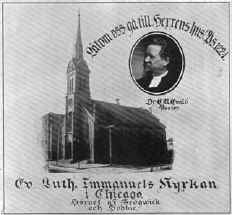
Immanuel Church at Sedgwick and Hobbie, destroyed in 1871 Chicago Fire. [Insert: Carl Evald, Erland Carlsson's successor]
Immanuel Lutheran Church, Chicago, Illinois | Augustana came into the Lutheran Church in America in 1962 with 1,220 congregations and 619,040 members. They also came with institutions of social ministry and educational ministry. While all were part of the heritage, some have stories which can help chart the course for 21st century mission.
If you don't know who "Mother Immanuel" is, you must not have grown up as a Swedish Lutheran in Chicago, Illinois. When Immanuel celebrated her 125th anniversary in 1977, the commemorative booklet claimed significance beyond the north side of Chicago:
It was through Immanuel that seven other Chicago churches were founded, that Augustana College and Theological Seminary was first housed, that Augustana Hospital had its beginnings, that the forerunner of Augustana Book Concern found shelter, and that the ministry of social welfare was initiated among the Augustana churches.
What you have heard of is the Chicago Fire of 1871. And therein we see the wonder that "Mother Immanuel" even survived.
It was maybe a typical beginning, when some immigrants arrived in Chicago back in 1852. A Norwegian pastor Paul Andersen (sic) took care of them for a while during a cholera outbreak. Then Pastor Tuve N. Hassesquist arrived from Sweden and assured them that he would return and organize a church for the immigrants. This he did on January 16, 1853. It took until August before their first pastor Erland Carlsson came.
Carlsson led Immanuel through the terrible 1854 cholera year (one-tenth of the congregation's members died), a building program for the church at Sedgwick and Hobbie ("largest and most imposing structure owned by any Augustana parish"), and the Chicago Fire which destroyed the church and the homes of 90% of the congregation. The people were moved to declare bankruptcy.
Carlsson was moved otherwise: "If you intend to go into bankruptcy, I will no longer be your pastor. But if you will be honest and put your trust in the Lord, I will do my utmost that we may both get a new church and pay our debt." And it was so.
While the "rest is history," you should also know about Emmy Evald, daughter of Carlsson and wife of Immanuel's second pastor Carl Evald. She was an extraordinary 19th century feminist who, in company with Susan B. Anthony, made the case for women's voting rights before a congressional committee in 1902: "Swedish women stand as the first women who have been granted enfranchisement, for Swedish women voted before any American man voted (1736)."
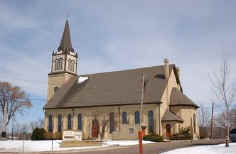
Chisago Lake Lutheran Church, Center City, Minnesota
Chisago Lake Lutheran Church, Center City, Minnesota | When the Augustana Synod came into being at Jefferson Prairie (near Clinton), Wisconsin, June 1860, there were 3,747 communicants in 36 "Swedish" congregations. It was mostly an upper Midwest gathering of the faithful. Fifteen congregations were in Illinois and 13 in Minnesota.
"We can't find a pastor." So goes the lament of many a lay leader in the ELCA and the predecessor churches. This is not a new problem. The good folk of Chisago Lake settlement had nearly a decade of disappointments before their first permanently called pastor, Carl August Hedengran, arrived in October of 1859. Even he was not a Swedish pastor, which the congregation desired, but at least he was born in Sweden.
Hedengran was licensed as a pastor, but was properly ordained on June 10, 1860, at the organizational meeting of the Augustana Synod, following instruction by Pastor Olof C. T. Andrén in Moline, Illinois.
The commitment of the ELCA to ecumenism likely would have been viewed with jaundiced eye by those Chisago Lake lay leaders as well. Veteran Augustana historian, the Rev. Eric Norelius, had arranged for Gustaf Palmquist (schoolteacher and religious leader) to come from Sweden in 1851. The congregation had hoped he would become their pastor, but by 1852, they learned that Palmquist was now a Baptist. Enter Gustaf Unonius, rector of St. Ansgar Episcopal Church, Chicago, Illinois. He visited Chisago Lake settlement and many other places in Minnesota. He warned people about "sects" and pushed the Episcopal agenda. In 1853 he even offered to come and be their pastor. By this time the people, though they liked Unonius, had come to the position that the pastor must be not only Swedish, but also Lutheran.
We cannot begin to tell the stories of Chisago Lake lay leaders and their faith commitment. We can tell you what Per Anderson wrote to Eric Norelius in the fall of 1851:
In the matter of church I must say that it is quite depressing here as there are so few, almost no one, with whom to speak about the unmerited grace in Christ. For this reason there are no dissensions in religious matters, but everything is as though dead, but I trust in the Lord that He will soon establish a congregation here. Anderson had to wait three years before Pastor Erland Carlsson came to organize the congregation on May 12, 1854. Maybe that was "soon" enough.
Not much hope here: little interest in spiritual matters, lack of pastoral leadership, ecumenical "competition," to say nothing of a remote settlement "in the boonies." So, you go figure: How is it that at the time of Augustana Synod's birth in June of 1860 the Swedish Evangelical Lutheran congregation at Chisago Lake was the largest of the 36 congregations, with 360 communicants?
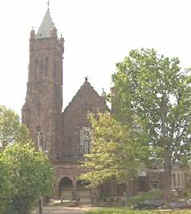
First Lutheran Church at Chandler and Center Streets, Jamestown, New York. A "cathedral" church for the Augustana Synod.
First Lutheran Church, Jamestown, New York | When the Augustana Synod was organized in 1860, only two of the 36 congregations were outside the Midwest. There are many Lutheran congregations in eastern U.S.A. which are much older. What Augustana did was to gather and organize Swedish immigrants who shared common traditions from the old country, particularly Lutheran liturgy and catechism.
Unlike gun-slingers of western lore who said "This town isn't big enough for the two of us," Swedish Lutheran Christians in Jamestown, New York, managed to co-exist and even prosper in new congregations. Sometimes it was the result of internal conflict, sometimes not. In any case, the ELCA claims four active congregations in this city of some 30,000 people tucked into the southwest corner of New York.
When you visit Jamestown, you quickly learn that while all the Lutheran Churches are beautiful, First Lutheran is "the cathedral." Don't write and remind us that Augustana did not have dioceses and bishops and cathedrals. We know that. However, it was traditional in Augustana for ordinations to be celebrated in conjunction with the annual "synod," and First Lutheran Church has had more than its share. In fact, Dr. Paul Westerberg, senior pastor (1950-1976) was ordained in Jamestown in 1931.
The beginnings go back to the mid-19th century. It started with laymen: Per Adolph Lorene who conducted services in homes, and B. C. P. Berglund who arrived in 1851 and soon became the leader of the Swedish Lutheran community. On June 1, 1853, the first known ordained pastor, Dr. Tufwe Nilsson Hasselquist, conducted a Swedish Lutheran service in Jamestown—in a Presbyterian Church (whereabouts unknown). Hasselquist licensed Berglund to preach for one year.
Hasselquist looked to Sweden for pastoral leadership for what were now two Lutheran groups: Jamestown, New York, and Chandlers Valley, Pennsylvania. A blacksmith answered the call. Jonas Swensson did indeed plan to be a blacksmith, but he elected to study for the ordained ministry and was ordained in Sweden October 7, 1851. It took five years for Swensson and his family to get to Jamestown (New York, not Virginia!). That same month, July 26, 1856, the Swedish Lutheran Church was organized to "serve Jamestown, Chandlers Valley, and Wrightsville."
Plans for the "cathedral" at Chandler and Center Streets were adopted May 18, 1892. The building was dedicated on September 22, 1901. You might ask, "What took so long?" Alas, there was the failing health of a pastor, dissatisfaction within the congregation, along with the usual angst that accompanies all church building programs. Nevertheless, when completed, First Lutheran Church was the largest church building in the Augustana Synod.

Former Swedish Lutheran Church, Fourth and Elm Streets, St. Peter, Minnesota. The church is now located at 1114 West Traverse Road, St. Peter, Minnesota.
First Lutheran Church, St. Peter, Minnesota | When the Augustana Synod came into being in 1860, it had but 36 "Swedish" congregations, of which 13 were in Minnesota. There were 13 "Norwegian" congregations, but they left (amicably) in 1870. At the farewell event, there was "brotherly hand-shaking and deep emotions." The Norwegians, alas, split into the Norwegian-Danish Augustana Synod and the Norwegian-Danish Conference. "High Church" and "Low Church" divisions and status of lay leaders were issues not limited to the Norwegians.
No history of Augustana is complete without St. Peter, Minnesota. Gustavus Adolphus College (founded in 1826 at Red Wing) was moved there in 1876. Long before that, a congregation came into being, "First Swedish Evangelical Lutheran Church." But when? The official document says November 28, 1857. But now listen to a paragraph of Mrs. Rufus Logan's history of First Lutheran (1957):
The earliest members of our church are recorded as having joined the church with their wives and baptized children on October 5, 1856. In the earliest printed general reports, 1856 was given as the year church was founded. Before long, however, 1857 was substituted, for it was reorganized and incorporated then. This reorganization which took place at a meeting in St. Peter on November 28, 1857, was still the work of laymen. They had, however, been visited by and listened to the preaching of the Rev. T. N. Hasselquist in July and the Rev. T. A. Cederstam (who served two parishes and did a little farming) about the end of October, 1857. At this meeting it was decided that the legal name should be "First Swedish Evangelical Lutheran Church."
The Rev. J. Millard Ahlstrom, pastor 1952-1978, found a copy of the original document when he began work in the parish. It is a remarkable document of 18 "resolutions." Number 3 states the obvious Augustana party line about Scripture as "infallible" and the unaltered Augsburg Confession, except the fourteenth article having to do with polity.
They made it clear in number 5: "Should the congregation not be able to afford, or not be able to secure a teacher (preacher) for some length of time, the congregation has the right to select someone from his own membership to preach and conduct the service to the best of his ability and in accordance with Holy Writ." Luther's Book of Homilies are recommended. Deacons and trustees are also free to use preachers from other denominations as long as they stick to Scripture.
The founding fathers apparently deemed Augsburg 14 not applicable to pioneer conditions.
Be that as it may, the laity of First Lutheran Church and their descendents not only built up a strong congregation, but also distinguished themselves in government and military service, both in Minnesota and indeed the U.S.A. Not only that, but the list of pastors is a "who's who" in the Augustana Ministerium.
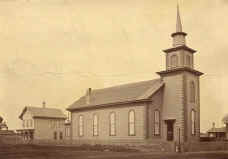
The "old" church, moved from 14th Avenue and Washington to 8th Avenue and 5th Street, and it was sold to Dr. W. A. Passavant for an English mission.
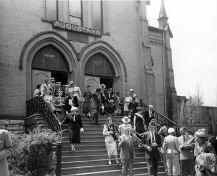
The "new" church, 11th Avenue and 7th Street, dedicated June 24, 1883.
Augustana Lutheran Church, Minneapolis, Minnesota | When did "Augustana," a Latin word, become the code for Swedish Lutherans in America? Until 1870, both Norwegians and Danes, especially the theologically conservative, could claim that was their faith base too. Many an Augustana congregation started out as "Swedish Lutheran Church" in this place or that, only to change to "Augustana Lutheran Church" in a few years. If it were not their congregation's name, it would surely be their synodical allegiance. When the LCA came into being in l962, of the 1269 congregations in U.S.A. and Canada, 42 were called "Augustana."
Lutheran Christians are everywhere in the Twin Cities. Gathering a congregation in the mid-19th century in Minneapolis surely must have been "a piece of cake." Wrong.
Part of this was rural bias. In a little article about "First Augustana" in Minneapolis, Dr. Charles Foelsch describes the city as "only a rugged frontier hamlet, with rather a bad name too." He cites a rural pastor who, on hearing that one of his families was moving to Minneapolis, wondered why they were tempting kind Providence to settle in "a barbarous and heathenish place like Minneapolis."
Consider this: the first Swedish man moved to Minneapolis in 1851. In December of 1857, young Peter Carlson, an aspiring preacher, rode into town looking for Lutherans. He was welcomed by a Swedish pioneer family, and after rounding up five young people, he preached in that home the week before Christmas. It was probably the first Lutheran sermon heard in Swedish in Minneapolis. One congregational record says this was actually Pastor Erland Carlson. Either way, it was a small and slow beginning.
Of course, the Swedes did come. As their numbers increased, ordained Swedish pastors did visit from time to time, the faithful meeting in homes, often at the Vannstroms who were to become charter members of Augustana. Enter Pastor Eric Norelius, who in October, 1865, conducted a public service in Chutes school house on Central Avenue.
Pastor Peter Carlson returned to conduct the official organization in Knickerbocker Church, Hennepin and Fourth, on April 16, 1866. There were 12 communicants. Remember that these were Norwegians as well as Swedes. This helps explain the last words of their one long sentence resolution: "...we unite ourselves in the founding of a Lutheran congregation, under the name of the Evangelical Lutheran Augustana congregation in Minneapolis, Minnesota." When the Augustana Synod met in Decorah, Iowa, June 18, 1867, Augustana (Minneapolis) became part of Augustana (Synod).
The congregation is now located at 704 11th Avenue South, Minneapolis. Their website features an essay by Pastor Herbert Chilstrom, "What Was/Is Augustana?," which could well be ascribed to most of these pioneer Lutheran Christians anywhere in America: Augustana means "personal piety, dignified worship, social consciousness, and global awareness."
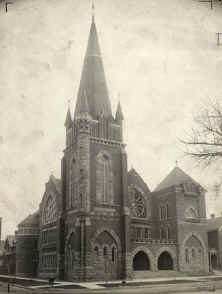
Augustana Lutheran Church, Denver, Colorado, the "second church", 1890-1959. Presently located at 5000 East Alameda Avenue, Denver, Colorado.
Augustana Lutheran Church, Denver, Colorado | Augustana in not a Swedish name. It's Latin, as in Confessio Augustana. Eric Norelius made the suggestion to name the new synod that way because of the concerns of the Swedes and Norwegians to adhere to the "unaltered Augsburg Confession." And it stuck. Consider how Church, College, Seminary—to say nothing of many a congregation—have named themselves "Augustana" without a single apology to anglophiles. But the Swedes liked the Latin formality. You could never imagine the great reformers of the Church of Sweden being called "Ole and Lars Peterson." Never. It is Olaus and Laurentius Petri.
The seven pioneers could hardly imagine what was ahead of them. Six women and one man gathered in the small chapel of the German Methodist Church, Arapaho and 18th Streets, Denver, Colorado, September 20, 1878, and organized "The Swedish Evangelical Lutheran Church in Denver, Colorado." They petitioned the Augustana Synod to be received into its fellowship.
It took a couple years, but on April 26, 1880, with Dr. Johannes Telleen as pastor and eleven members, they incorporated as Augustana Lutheran Church and were admitted to Synod membership in June. Since they hoped to serve all the Swedish people in the Denver area, it must be inferred that "Augustana" by this time had Swedish meaning to people all over the country. Moreover, even though they began to worship in English in the early 1920s, Swedish services were offered until 1953.
Augustana in Denver enjoyed impressive growth over the years, led by many faithful pastors. Effective and appropriate ministries were inaugurated over the years: Augustana Lutheran Home, Radio KOA Denver, day care center, Augustana Foundation, senior citizens complex, to name a few. If anyone thought Augustana Synod was destined to be a parochial, rural, Midwestern organization, Augustana Church in Denver shows how the Confessio Augustana is Good News in any cultural setting.
When the Augustana Synod (Augustana Evangelical Lutheran Church) became part of the LCA in 1962, she listed 16 congregations in Colorado, with Augustana Lutheran Church in Denver bringing 2317 baptized Christians into the new church. Only two of these Colorado congregations were identified as "rural."
There's more to Augustana than lutfisk. There's faith and adaptability.